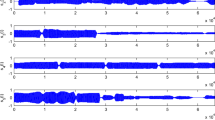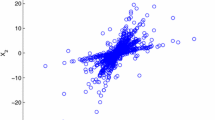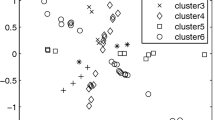Abstract
Due to the lack of sufficient prior information, how to estimate the mixing matrix in multiple underdetermined blind source separation (UBSS) models is a difficult problem. This study proposes an algorithm, which is used for the estimation of mixing matrix in instantaneous UBSS. Firstly, we propose an efficient single-source-points detection criterion with the transformation for the mixed signal vector, which is used as the basis for the clustering process. There are some shortcomings in the classical clustering algorithms, including the dependence on input parameters, restrictions on the data dimension, the requirement of the prior knowledge of the source signals and high complexity. To overcome these drawbacks, the modified density peaks clustering algorithm is used for the estimation of the initial clustering centers to adapt to different circumstances. Based on the idea of mean clustering, the single source points near each initial cluster center are processed, respectively, and the final estimation results of the mixing matrix are obtained. A variety of simulation experiments demonstrate the universality and validity of the proposed algorithm. The proposed method also has excellent performance even under the circumstance of low signal-to-noise ratio.







Similar content being viewed by others
References
Bofill, P., Zibulevsky, M.: Underdetermined blind source separation using sparse representations. Signal Process. 81(11), 2353–2362 (2001)
Zhen, L., Peng, D., Yi, Z., et al.: Underdetermined blind source separation using sparse coding. IEEE Trans. Neural Netw. Learn. Syst. 28(12), 3102–3108 (2017)
Simas Filho, E.F., de Seixas, J.M., Caloba, L.P.: Modified post-nonlinear ICA model for online neural discrimination. Neurocomputing 73(16–18), 2820–2828 (2010)
Naik, G.R., Kumar, D.K., Palaniswami, M., Palaniswami, Marimuthu: Signal processing evaluation of myoelectric sensor placement in low-level gestures: sensitivity analysis using independent component analysis. Expert Syst. 31(1), 91–99 (2014)
Kolda, L., Krejcar, O., Selamat, A., et al.: Multi-biometric system based on cutting-edge equipment for experimental contactless verification. Sensors 19(17), 3709–3731 (2019)
Zhang, L., Yang, J., Lu, K., et al.: Modified subspace method based on convex model for underdetermined blind speech separation. IEEE Trans. Consum. Electron. 60(2), 225–232 (2014)
Xu, J.D., Yu, X.C., Hu, D., et al.: A fast mixing matrix estimation method in the wavelet domain. Signal Process. 95(2), 58–66 (2014)
Zhang, Y., Zhang, S., Qi, R.: Compressed sensing construction for underdetermined source separation. Circuits Syst. Signal Process. 36(11), 4741–4755 (2017)
Zhang, Y., Shi, X., Chen, C.H.: A Gaussian mixture model for underdetermined independent component analysis. Signal Process. 86(7), 1538–1549 (2006)
Sidiropoulos, N.D., De Lathauwer, L., Fu, X., et al.: Tensor decomposition for signal processing and machine learning. IEEE Trans. Signal Process. 65(13), 3551–3582 (2017)
Lu, F., Huang, Z., Jiang, W.: Underdetermined blind separation of non-disjoint signals in time-frequency domain based on matrix diagonalization. Signal Process. 91(7), 1568–1577 (2011)
Reju, V.G., Koh, S.N., Soon, Y.: An algorithm for mixing matrix estimation in instantaneous blind source separation. Signal Process. 89(9), 1762–1773 (2009)
Thiagarajan, J.J., Ramamurthy, K.N., Spanias, A.: Mixing matrix estimation using discriminative clustering for blind source separation. Digital Signal Process. 23(1), 9–18 (2013)
Fu, W., Zhou, X., Nong, B., et al.: Blind estimation of underdetermined mixing matrix based on density measurement. Wirel. Pers. Commun. 104(4), 1283–1300 (2019)
Jourjine, A., Rickard, S., Yilmaz, O.: Blind separation of disjoint orthogonal signals: demixing N sources from 2 mixtures. In: IEEE International Conference on Acoustics, Speech, and Signal Processing, pp. 2985–2988 (2000)
Abrard, F., Deville, Y.: A time-frequency blind signal separation method applicable to underdetermined mixtures of dependent sources. Signal Process. 85(7), 1389–1403 (2005)
Li, Y., Amari, S.I., Cichocki, A., et al.: Underdetermined blind source separation based on sparse representation. IEEE Trans. Signal Process. 54(2), 423–437 (2006)
Aissa-El-Bey, A., Linh-Trung, N., Abed-Meraim, K., et al.: Underdetermined blind separation of nondisjoint sources in the time-frequency domain. IEEE Trans. Signal Process. 55(3), 897–907 (2007)
Guo, Q., Ruan, G., Nan, P.: Underdetermined mixing matrix estimation algorithm based on single source points. Circuits Syst. Signal Process. 36(11), 1–15 (2017)
Li, Y., Nie, W., Ye, F., et al.: A complex mixing matrix estimation algorithm in under-determined blind source separation problems. Signal Image Video Process. 11(2), 301–308 (2017)
Zhang, C., Wang, Y., Jing, F.: Underdetermined blind source separation of synchronous orthogonal frequency hopping signals based on single source points detection. Sensors 17(9), 2074–2093 (2017)
He, X., He, F., Cai, W.: Underdetermined BSS based on K-means and AP clustering. Circuits Syst. Signal Process. 35(8), 2881–2913 (2016)
Alshabrawy, O.S., Ghoneim, M.E., Awad, W.A., et al.: Underdetermined blind source separation based on fuzzy c-means and semi-nonnegative matrix factorization. In: 2012 Federated Conference on Computer Science and Information Systems, pp. 695–700 (2012)
Dong, T., Lei, Y., Yang, J.: An algorithm for underdetermined mixing matrix estimation. Neurocomputing 104, 26–34 (2013)
Sun, J., Li, Y., Wen, J., et al.: Novel mixing matrix estimation approach in underdetermined blind source separation. Neurocomputing 173, 623–632 (2016)
Rodriguez, A., Laio, A.: Clustering by fast search and find of density peaks. Science 344(6191), 1492–1496 (2014)
Acknowledgements
Thanks to the National Key Research and Development Program of China (No. 2016YFF0102806) and the National Natural Science Foundation of China (No. 61701134) for providing funding. Moreover, this work is supported by the Natural Science Foundation of Heilongjiang Province, China (No. F2017004).
Author information
Authors and Affiliations
Corresponding author
Additional information
Publisher's Note
Springer Nature remains neutral with regard to jurisdictional claims in published maps and institutional affiliations.
Rights and permissions
About this article
Cite this article
Li, Y., Wang, Y. & Dong, Q. A novel mixing matrix estimation algorithm in instantaneous underdetermined blind source separation. SIViP 14, 1001–1008 (2020). https://doi.org/10.1007/s11760-019-01632-z
Received:
Revised:
Accepted:
Published:
Issue Date:
DOI: https://doi.org/10.1007/s11760-019-01632-z




